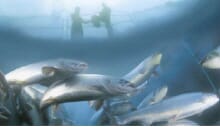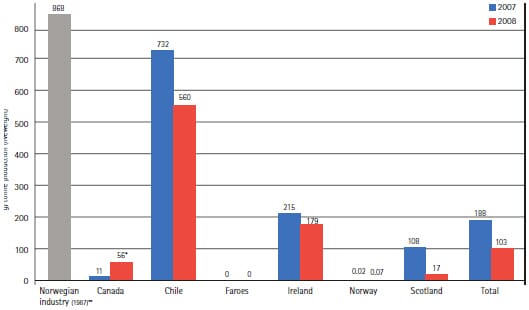Good farming practices aim at rearing fish under conditions that suit their biological needs and use husbandry techniques that minimise stress, aggression and injury.
Health management is based on frequent monitoring of the health status of the fish, with rapid response when this status is compromised. When responding Marine Harvest will use only permitted medicines as prescribed by specialist veterinarians. In the interests of continuous health improvement across the aquaculture industry, Marine Harvest cooperates with vaccine manufacturers in the development of new vaccines.
Farming practices

Good farming practices include aspects such as feed formulation, feed management and stocking density. Correct feed formulation ensures that the fish obtain the nutrition they require for a healthy existence. Efficient feed management ensures that they have access to the feed they need, without over-feeding. Stocking density (the number of fish per cubic metre in the pens) should be kept at levels that ensure the well being of the fish.
Further aspects of fish welfare in farming practices relate to minimising stress at times of handling the fish for processes such as grading and vaccination. The last stage in which a responsible aquaculture company such as Marine Harvest aims to minimise stress is in the lead up to slaughter. Marine Harvest has made significant advances in this stage and these are described later.
Stocking density
Holding too many fish in a net pen would not be a sound farming practice as overcrowding would lead to poor animal welfare standards, subsequent poor stock performance, and increase the risk of spreading disease.
Stocking density in a net pen will start low as the fish are first introduced and increase as they grow. In Marine Harvest, the specified stocking densities at harvest are around 1525 kg per cubic metre (1,000 litres of water), depending on the location. This means that even at maximum stocking rates the fish occupy less than 3 per cent of the cage volume and have more than 97 per cent of the space for free movement. Although they have this space available, the fish often congregate and swim together as a school.
Factors such as temperature can affect the rate of growth of the fish. At the same time, poor weather conditions may delay harvests in the interests of fish welfare and the health and safety of employees. In combination these factors may lead to the stocking density exceeding the target maximum for a short period.
| Stocking density reported in 2008 in kg/m | |||
|---|---|---|---|
| Country | Target maximum | Actual maximum | % of Pens Exceeding Maximum |
| Canada | 24 | 29.4 | 7.5* |
| Chile | 17 | 14 | 0 |
| Faroes | 20 | >20 | 5** |
| Ireland | 20*** | 15 | 0 |
| Norway North | 25 | 24 | 0 |
| Norway Mid | 25 | 25 | 0 |
| Norway West | 20 | 20 | 0 |
| Norway South | 20 | 23 | 2 |
| Scotland | 17 | 19 | 4 |
|
*A reduced target of 24 kg/m3 was set during 2008 and the actual maximum relates to the previously stocked fish representing 50% of the operating pens in 2008
**No pens exceeded the legal limit of 25 kg/m ***For the production the production of Clare Island Organic Salmon in Ireland, the maximum stocking density is 10 kg per cubic metre. |
|||
PROGRESS IN 2008
Welfare parameters around stunning
Marine Harvest Norway is co-funding a research project with the University of Bergen and a research institute in Belgium to identify the parameters by which to assess the welfare of the fish in the approach to slaughter. The ultimate objective is to find the most humane method of slaughter.
The use of carbon dioxide is currently the most widespread stunning method applied in the Norwegian industry. This method will be phased out as the sole stunning method in the future. However, satisfactory alternatives are not yet available. Application of the well-functioning automated percussion stunning system pioneered in Marine Harvest Scotland is difficult for several reasons.
Most of the fish in Norway are transported to processing in flow-through wellboats, a transportation system which makes the fish more active at point of arrival than if done in contained systems. Also, there is not capacity available to transport the Norwegian harvest volume in contained well boats as applied in Scottish standards. Furthermore, fish harvest size in Norway is generally bigger than in Scotland which means fish would be more prone to self-inflicted damage during handling in the system applied in Scotland. Alternative methods like electro-stunning have been trialed, but this method provides even less accuracy and predictability.
Innovation in Canada and Norway
An innovative harvesting method was introduced by Marine Harvest Canada which improves fish welfare during harvesting. At the same time it has reduced costs and improved product quality. The technology is being transferred to Marine Harvest Norway. A specially constructed boat travels to the production site and the fish are channelled so that they swim to the point of stunning and are only out of water for less than one second before being stunned, thereby minimising stress from lack of oxygen. Immediately after stunning the fish are bled and chilled to 1C.
Additionally, the system dispenses with the need to move live fish to slaughter in an open well boat. Instead, they are moved after slaughter and in a closed vessel. That brings two further benefits. The boat can carry several times as many fish, thereby reducing fuel consumption and the production of greenhouse gases. As the vessel is closed, it brings a higher level of biosecurity to the transporting of the fish.
In a tri-lateral funded project Marine Harvest Norway, the boat owner Napier and Innovation Norway have invested NOK 50 million in a larger version of the Canadian boat in 2008. This came into service in Norway, region South, in January 2009.
AMBITIONS FOR 2009
The primary intentions for 2009 are to maintain the current attention to the welfare of farmed fish in Marine Harvest. Additionally, Marine Harvest will continue progress in the research and development of improved practices in the period leading up to and including stunning.
An investigation into stronger materials for the nets used in pens which would protect the fish from the stress of predator attack is described in the next chapter.
Health management
ISA in Chile
The major disease topic of 2008 was the continuing outbreak of Infectious Salmon Anaemia (ISA) throughout the industry in Chile. This is described in more detail in the section on Chile, page 35.
PD in Norway
The other significant disease affecting Marine Harvest in 2008 was Pancreas Disease (PD), mainly affecting Marine Harvest Norway. By mid year summer is the peak season for PD the industry in Norway had 42 confirmed sites, with 11 belonging to Marine Harvest.
The PD Steering Group, headed by Marine Harvest Norway, has developed a joint industry master plan against PD, counting multiple operational and structural measures including vaccination against the disease. In combination with precautionary measures relating to the use of equipment and well boats, the PD master plan is believed to have helped to hold the disease in check.
There were no outbreaks at Marine Harvests Norwegian sites in the final four months of the year, compared with five in the same period of 2007.

*The rise in Canada in 2008 was due to two treatments for a common bacterium at a single farm and does not represent
a general upward trend in the use of antibiotics. The five year trend for antibiotic use for MH Canada is about 11g/tonne.
**Norwegian Seafood Federation (FHL)http://www.fhl.no/statistikk/antibiotikabruk-article410-10.html
Medicines
Vaccination
In 2008 100 per cent of Marine Harvest salmonids were vaccinated against diseases relevant to their location and where registered vaccines were available. In 2008, Marine Harvest Chile vaccinated 100 per cent of its fish in Chile against SRS (Salmonid Rickettsial Septicaemia, Piscirickettsia salmonis) using newly available vaccines. This followed numerous laboratory tests and field trials by Marine Harvest with candidate SRS vaccines since 2006 to determine both effectiveness and safety. This vaccination programme contributed to a reduction in antibiotic use, see below. There was no approved, effective vaccine to combat the ISA virus.
Antibiotics
As with other animals and humans, both wild and farmed fish are susceptible to attack from infectious pathogens. If left untreated, infectious diseases can compromise welfare and cause mortalities. Any drug used by Marine Harvest is approved by the competent authorities in the production country. No drugs are used prophylactically or to promote growth.
Drugs are prescribed by certified veterinarians only and strict withdrawal periods are held to assure residue levels are within legal limits of the destined market.
38,492 kg of antibiotics were used by Marine Harvest Group in 2008 for disease control, a reduction from 74,057 kg in 2007. For salmonid production, total liveweight produced in 2008 was 373,874 tonnes resulting in an average of 103g antibiotic per tonne produced, a reduction from 188.6g per tonne in 2007. This development accounted for an overall decrease in antibiotic use of 45.2 per cent from 2007- 2008 in Marine Harvest Group salmonid farming.
The difference from 2007 was mainly due to a substantial reduction in Chile where Marine Harvest undertook an active campaign to decrease the volume of antibiotics used. In addition, early in 2008, Marine Harvest Chile implemented a strategy to vaccinate 100 per cent of smolts against SRS (Salmonid Rickettsial Septicaemia). The effect of this strategy was a reduction in antibiotic use of 23.5 per cent from 2007- 2008. Despite this, and due to existing unvaccinated standing stock, Chile continued to be the main user of antibiotics in Marine Harvest Group as there were fewer effective vaccines available to combat the main bacterial disease problems.
Norway, the country with the most mature salmon farming industry, demonstrates how the need for antibiotics is reduced as the industry develops. Marine Harvest Norway used only 15 kg of antibiotics in 2008. Peak consumption of antibiotics in Norwegian aquaculture occurred in the late 1980s and early 1990s when approximately 49 tonnes of antibiotic were used in the production of around 56,000 tonnes of salmonids.
Antifungals
Products are used in hatcheries and freshwater production to protect eggs and fry from fungal attack. In 2008 a total of 72,866 litres were used in Marine Harvest operations (158,835 litres in 2007).
Sea lice treatments
As part of the control programmes for sea lice, in 2008 Marine Harvest used a total of 311 kg active ingredients in oral treatments (1,075 kg in 2007) and 96.5 kg bath treatments (41.5 kg in 2007), not including hydrogen peroxide.
June 2009




